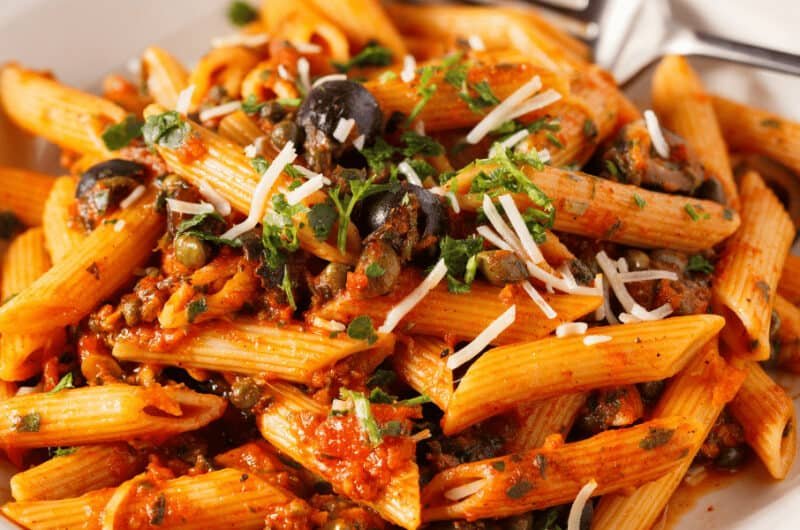Puttanesca sauce is the ultimate pasta sauce, full of sweet tomatoes, salty olives, anchovies and capers. But do all these ingredients freeze well? Is this a sauce that can be batch made?
Can You Freeze Puttanesca Sauce?
Yes, you can freeze puttanesca sauce for up to 3 months. Freezing puttanesca sauces isn’t just easy but encouraged as it gives you a nutritious and delicious meal ready to go from the freezer that tastes almost as good as it would when fresh.
Do Does Puttanesca Sauce freeze well? Yes
Can you refreeze Puttanesca SAuce? No
How To Freeze Puttanesca Sauce
When it comes to freezing your puttanesca sauce, the first step is to make it. If you’re looking for a recipe, this one from Gino D’acampo is a great place to start.
So first, knock together a big batch of sauce and then allow it to cool. Now you can get to freezing it:
- Get Prepared: Once your sauce is cool, grab a handful of thick freezer bags, label them now and then open them up wide so they’re easy to spoon sauce into. You need to decide what portion size you’ll be using. How many of you will eat it in one sitting?
- Portion Out: Grab a ladle and spoon the sauce into each bag in portions.
- Seal: Seal the bags up, squeezing out as much of the air as possible as you do so.
- Freeze: Label the bags and place them into the freezer and you’re good to go.
How Long Can You Freeze Puttanesca Sauce?
Around 3 months is the longest you want to keep puttanesca sauce frozen. It will remain safe to eat after this time in most cases, but there is a greater risk that both the texture and flavour will degrade.
To enjoy it at its best, you should try to consume it within 3 months of freezing.
Puttanesca sauce will last in the fridge for around 3 days, keeping it in an airtight container. Before putting the sauce into the fridge, you must ensure it has cooled to room temperature.
How Do You Defrost Puttanesca Sauce?
The best method for defrosting your sauce is in the fridge overnight. Simply grab a bag of sauce and place it into a bowl to thaw out. It will need to be left alone overnight.
Another approach is to submerge the sauce in a bowl of cold water for a couple of hours. In most cases, this will thaw the sauce enough to reheat.
The good news is that the sauce doesn’t need to be completely thawed out. Once it’s partially there, you can begin to warm it over a very low heat.
Can You Refreeze Puttanesca Sauce?
Refreezing puttanesca sauce is not something you will want to do.
You’ll end up ruining the texture of the sauce. What was once a rich, velvety sauce will become loose and watery. Instead, freeze your sauce in portions to avoid wasting it unnecessarily.
Although refreezing it is likely to be safe, it just makes sense to freeze it in portions that can be grabbed as and when.
Does Puttanesca Sauce Freeze Well?
Puttanesca sauce, like most tomato-based pasta sauces, freezes remarkably well. There’s a huge chance that you’ll be the only person to know it was from the freezer.
Of the many things you can freeze, having pasta sauce in the freezer for a quick midweek meal is a must!
Puttanesca Sauce Freezer Recipe
Stop serving your favourite pasta up with a generic tomato sauce. Instead, try this puttanesca sauce which is spiked with salty anchovies, olives and capers… And it freezes well too!
The quantities below are to serve 8. This is so you can make enough for dinner tonight whilst having plenty of leftovers that you can freeze:
Related FAQs
If you’ve still got questions about freezing puttanesca sauce or pasta sauce in general, then these may help:
Marinara pasta sauce can be frozen. Once the sauce has cooled, decant it into freezer bags in individual portions. Seal the bags up and pop them into the freezer.
Arrabiata sauce freezes really well. Simply freeze the sauce in portions using freezer bags. Ensure you write a clear label on the front of the bags, especially if you have frozen other pasta sauces.




How big are the tins of chopped tomatoes and anchovies? Here in the U.S. you can get canned tomatoes in any things from 8 ounce to 46 ounce cans.
Also are ‘chopped’ tomatoes the same as what in the U.S. are called ‘diced’ tomatoes (that usually have an additive that keeps the cubes of tomatoes firm) or with crushed tomatoes be a better alternative, or maybe whole tomatoes chopped up? (I don’t recall ever seeing product called ‘chopped’ tomatoes.)
Apologies for the confusion Shirley! One tin of tomatoes is 400g or 14oz. Crushed tomatoes would work best in this case. You certainly don’t want to use tomatoes with additives!